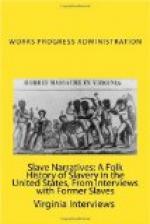Maryland 11/15/37 Rogers
Charles Coles, Ex-slave.
Reference: Personal interview with Charles Coles
at his home,
1106
Sterling St., Baltimore, Md.
“I was born near Pisgah, a small village in the western part of Charles County, about 1851. I do not know who my parents were nor my relatives. I was reared on a large farm owned by a man by the name of Silas Dorsey, a fine Christian gentleman and a member of the Catholic Church.
“Mr. Dorsey was a man of excellent reputation and character, was loved by all who knew him, black and white, especially his slaves. He was never known to be harsh or cruel to any of his slaves, of which he had more than 75.
“The slaves were Mr. Dorsey’s family group, he and his wife were very considerate in all their dealings. In the winter the slaves wore good heavy clothes and shoes and in summer they were dressed in fine clothes.
“I have been told that the Dorseys’ farm contained about 3500 acres, on which were 75 slaves. We had no overseers. Mr. and Mrs. Dorsey managed the farm. They required the farm hands to work from 7 A.M. to 6:00 P.M.; after that their time was their own.
“There were no jails nor was any whipping done on the farm. No one was bought or sold. Mr. and Mrs. Dorsey conducted regular religious services of the Catholic church on the farm in a chapel erected for that purpose and in which the slaves were taught the catechism and some learned how to read and write and were assisted by some Catholic priests who came to the farm on church holidays and on Sundays for that purpose. When a child was born, it was baptised by the priest, and given names and they were recorded in the Bible. We were taught the rituals of the Catholic church and when any one died, the funeral was conducted by a priest, the corpse was buried in the Dorseys’ graveyard, a lot of about 1-1/2 acres, surrounded by cedar trees and well cared for. The only difference in the graves was that the Dorsey people had marble markers and the slaves had plain stones.
“I have never heard of any of the Dorseys’ slaves running away. We did not have any trouble with the white people.
“The slaves lived in good quarters, each house was weather-boarded and stripped to keep out the cold. I do not remember whether the slaves worked or not on Saturdays, but I know the holidays were their own. Mr. Dorsey did not have dances and other kinds of antics that you expected to find on other plantations.
“We had many marbles and toys that poor children had, in that day my favorite game was marbles.
“When we took sick Mr. and Mrs. Dorsey had a doctor who admistered to the slaves, giving medical care that they needed. I am still a Catholic and will always be a member of St. Peter Clavier Church.”
Maryland
Sept. 20, 1937
Rogers
James V. Deane, Ex-slave.
Reference: Personal interview with James V. Deane,
ex-slave,
on
Sept. 20, 1937, at his home, 1514 Druid Hill Ave.,
Baltimore.




